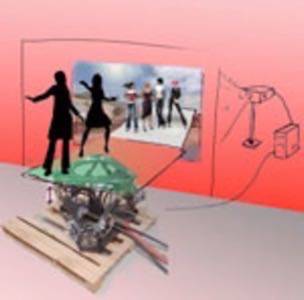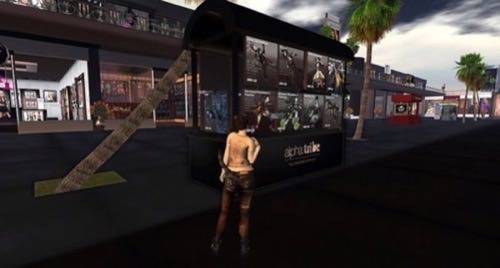Yesterday we explored an emerging trend called “Cross Reality”, one term for when sensor networks meet online virtual worlds.

As this trend becomes more common over the next few years (and it will, as both Web-connected sensors and virtual reality ramp up), what are the implications on how people use the Web? How will it change our interactions in both real and virtual life? In this post we’ll explore some of these issues and offer some ideas: for example a bookstore that offers you personalized, contextual information on your mobile phone, in real time and with virtual reality.
During my meeting at MIT with Joseph Paradiso, Associate Professor and Director of the Responsive Environments Group at MIT Media Laboratory, we discussed how connecting environmental sensors to the Web and virtual worlds will change the way people interact with each other and their environments. Essentially it will enable people to expose as much of their life online as they want – leading to an era of “ubiquitous media.” There are privacy implications for this, which we’ll discuss below. But let’s first look at the benefits.
Better and More Personalized Information
The more data that is exposed online about a person, the more personalized their media experience will be. This appears to be the most compelling argument for allowing your movements and interactions in the real world to be recorded and uploaded to the cloud. As long as there are privacy controls in place that allow people to opt out at any time (even for just a short period of time, e.g. if they’re having a private conversation with a friend), then the pay-off of a much more personalized and contextual media experience seems worthwhile.

Imagine for example walking down to your local shops and entering a bookstore. Theoretically, the bookstore would recognize you as you entered and would ‘ping’ your mobile device, which then might bring up that wish list of books you’ve been compiling (let’s assume it’s not an Amazon wish list, but an independent third party app – perhaps an opportunity for any entrepreneurs reading!). The app would let you know which of your wish list books are available. Also it would display a virtual map on your phone of exactly where each book is located in the store, via the barcodes of the books. Armed with all of this handy, very contextual information, you make your way to the first bookshelf…
You may say: well I could’ve just ordered the book on Amazon and not gone to the bookstore in the first place. But a lot of people still want that experience of going to their local shops and wandering around, socializing and being part of the ‘real world.’ By integrating the online world more deeply into the real world, it creates a more compelling shopping experience.
Changing the Way You Live
A more fundamental way in which sensors and virtual reality might mix is in your home. An example that Joe Paradiso mentioned was being able to control a thermostat in your home without even touching it. Instead it would be controlled by sensors connected to the Web. All you’d need to do is send your preferences into the Internet cloud, once. And the thermostats would control your home heating from there on out. You could also check in on your home when at work or traveling, on the virtual Web.

One does wonder what would happen though when multiple people live in the same house, but have different thermostat preferences! Well, let’s presume that the Internet will be able to work out an efficient sharing program for that too 😉
Changing Social Networking
Sensors and virtual reality will change social networking. Paradiso mentioned that you might have a Zigby badge, which would automatically post data to Facebook. For example when you entered that bookshop mentioned above, Facebook would get pinged. Theoretically then this will enable your friends in the vicinity to meet up with you, or you could make new friends if you allow people to ‘discover’ you at bookshops.
You could do this virtually too – e.g. if you find that you have great conversations whenever you’re in a bookshop, then why not try catching up with some friends via Second Life’s version of that bookshop (which connects in real-time to the real bookshop)? And what’s to stop you from visiting overseas bookshops, virtually, and meeting/making friends?

Wait, What About My Privacy?!
All of the above potential benefits (which just scratch the surface of what’s possible) sound marvelous, but of course we haven’t yet touched on the not insignificant privacy implications of living in a world enhanced by sensor data and virtual worlds.
This issue was discussed in the academic paper which we summarized in yesterday’s post. The paper asked what happens when “potentially invasive media capture becomes an intrinsic property of devices scattered all over our environments?”
To try and solve this issue, MIT is experimenting with a small badge that people can wear to “passively manage dynamic privacy” in environments where potentially sensitive information is streamed across real and virtual worlds. Such a device might be embedded in your mobile phone, or on your body somehow, in the near future. It’s early days, so don’t panic just yet about brain implants. But here is how MIT describes the current solution:
“We have elected to address this [privacy issue] with badge systems, which periodically beacon a unique ID, to wirelessly mediate privacy (a prototype privacy badge is shown in Figure 7). Using received signal strength and/or the localization engine, the Portals know which badges are potentially within sensor capture range, and can passively and dynamically control data access according to the badge users’ preferences. When the red “NO” button is pressed, however, an immediate opt-out signal is transmit to block any sensors in range – an important option if a sensitive conversation is initiated. The current protocol answers to the most restrictive privacy setting that is received. If we have any indication that the wireless network is being jammed or spoofed, the portals will revert to a conservative privacy level.”

Conclusion
Clearly much work needs to be done to enable people to effectively – and easily – control personal data from sensors. The benefits described above are compelling, but equally we want to ensure that our personal data is under our control and not being monitored by governments or corporations.
Now tell us what changes you forsee on the Web, as a result of the emergence of Web-connected environmental sensors and the continued growth of virtual worlds.
Image credits: sndrv; MorBCN; Alpha Auer; butkaj.com; Responsive Environments Group










